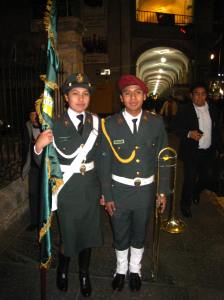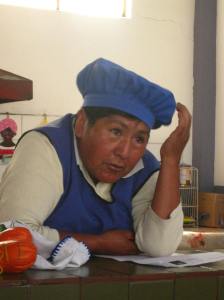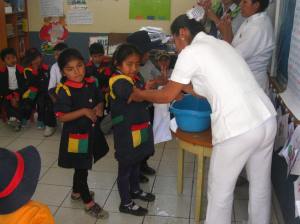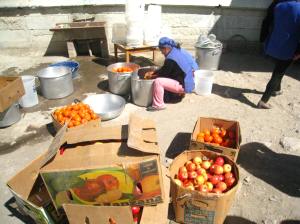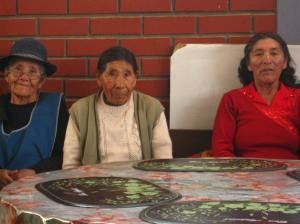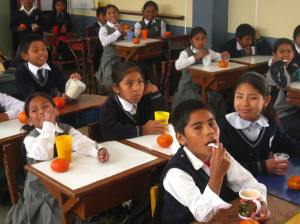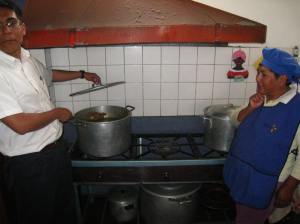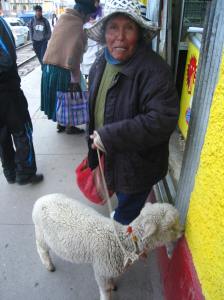Gaining Altitude
Altitude is not something to be trifled with. I’m reading Conversation in the Cathedral, the work by famous Peruvian novelist Mario Vargas Llosa which won him the Nobel Prize for Literature. The book contains a nauseating description of altitude sickness. Hipolito, a minor character, is a thug-for-hire contracted by dark forces within the military regime of Peru’s President Odria in the 1950s. He’s a nasty piece of work but he’s also a Liman and so when he’s sent to break up a political rally in the rebel mountain city of Arequipa (2,300m above sea level) the dizziness overcomes him. As the rally descends into a fist fight he’s unable to hold his own and is ultimately killed.
I was fine with the altitude in Arequipa but I’m writing this dispatch (altitude-assuaging coca leaves tucked inside my cheek) from the Andean city of Puno, which is about double Arequipa’s height above sea level. No major problems, but I certainly have noticed a difficulty in breathing after any physical exertion and a headache comes and goes. My bout is a lot milder than Hipolito’s, then, but ‘altitude sickness’ is certainly real. Our hotel is downtown in Puno and feeling out-of-sorts is not helped by the madding crowds of this lakeside city: the streets are teeming with women in traditional dress, pork pie hats and babies slung over their shoulders; hawkers of every hue; and – as in every Peruvian metropolis – legions of manic taxi cabs.
Coach travel in Peru is serious business. In the absence of a decent rail network, bus journeys can be reminiscent of long distance air travel. We travel with the main company, Cruz del Sur, which offers blankets, pillows and reclining seats for weary travellers. Mini-televisions in the back of seats show the latest Hollywood movies. Hot meals are served by the onboard crew. And there’s heavy security to ward off the bandits with all coaches tracked by satellite.
That’s business class. After that we travelled south between Ica and Arequipa, this time in second class and it’s a slightly different story. You’re told in business class that not wearing your seatbelt is a criminal offence. In second class, as the coach winds dizzyingly through tight mountain passes, I enquire as to where my seatbelt is. I’m told that my seat doesn’t have one. Peru’s road safety record isn’t great, but I accept this and try to fall asleep. It’s an overnight journey of twelve hours duration. Annoyingly, I’m woken at 7am by a big game of bingo with the conductor as the announcer. This is followed by loud slapstick comedy on the TV screens. It feels like cheap entertainment for the masses.
The Rebel City
But so what? We’re in Arequipa to visit more communal dining rooms. Volcanic mountains tower over this picturesque conquistador city, which is refreshingly green compared to Lima’s unrelenting grey. Arequipa is where Peru gets most of its milk and Fresian cows loll in the sunshine, beneath centuries-old Incan agricultural terraces. It’s also a well preserved colonial city with beautiful facades that are best described as Incan baroque.
This weekend happened to be the twenty-sixth anniversary of the (re)founding of the Peruvian national police and the cops are here in force, especially the police band. It’s also the festival of Santa Rosa, the patron saint of the national police. Policemen and women strut around the place resplendent in smart green uniform with gold trim, pistols tucked in their holsters, while band members lug cymbals and trombones and flags about with them. Arequipa is the home of Vargas Llosa, and has historically been the starting place for many Peruvian revolutions, with change sweeping down from the high plains into Lima. So it’s a little odd to see the state out in such force in this heterodox, free-thinking, pretty mountain city. Some young protesters agree, moving through the crowds in the central square with placards proclaiming ‘culture is more important’.
Reducing Child Malnutrition
In contrast to the ‘popular’ communal dining ventures we’ve visited so far, the sites we’re visiting in Arequipa are run by the Catholic Church. Brother Victor Ramos is our guide. He takes us to the Arequipan shanty towns of Ville Cerrillos and Paucarpata. We see a primary school that has been set up by donations from the Church and other charitable bodies. The Nada Marquez school provides more than just education. For just one sole (£0.25) a week, families can buy their child breakfast and lunch at the school. The preparation of the food is done by local mums, who volunteer their time for free. Amazingly – given work pressures on poor men not to mention the Peruvian culture of machismo – Brother Victor has succeeded in recruiting four of the local men to cook voluntarily too.
The success of the scheme has been astounding. Nutritionists put child malnutrition at 70% when the school meals started a decade ago. Today it’s 9%. And it’s thanks to the introduction of simple foods such as mandarins, cereal, soya and rice into a staple diet dominated by the potato. Importantly, the school also provides lessons in basic hygiene and healthy eating for kids and parents alike. In a teeming slum in which there is only one water pump, which is only operative for one hour per day, teaching the basics about hygienic food preparation is essential.
The Catholic Church
Later we visit the Santa Rosa community kitchen. Like all community kitchens, this one has its patron saint. But unlike the majority, this one is run by the Catholic Church exclusively for old people. It’s the cheapest comedor we’ve visited yet. Just half a sole (£0.12) gets you a good, nutritious plate of food. Grandmothers and a handful of grandfathers congregate there every day to chat and eat. It’s great to see loneliness in old people being combated through such a simple formula: come, eat, chat. There’s also education here: in embroidery, knitting, and – notably – catechism. Food is bought through donations at masses in Arequipa. The Santa Rosa feeds 25 people a week and 5 of them don’t pay anything at all.
It’s a clear reminder that in Peru churches – predominately the Catholic – play a big role in ensuring food security. Sure, the state may provision comedores populares. But in terms of social security there’s still a sizeable vacuum. Around 30% of people in Peru don’t have ID cards. And without an ID card, you don’t qualify for any benefits. NGOs and faith initiatives fill that gap.
Placing this in context: the rise of Quinoa and all that
Vital information on the political context of all this was provided by a roundtable discussion at the Centro de Estudios Peruanos (Centre of Peruvian Studies) at San Pablo University, Arequipa. Dean of faculty Claudia Queiroz-Munis provided excellent hospitality and help throughout our stay in Arequipa and the academic discussion was chaired by History Professor Fernando Valle.
I addressed the roundtable (in Spanish) on our research so far, begging the participants to excuse my pronunciation. I ventured the theory that the comedores populares were an organic social movement which enjoyed its greatest strength in the late 70s, 80s and early 90s. This period coincided with the economic and political crisis facing Peru in these years: the hyperinflation of left-leaning Alan Garcia administration (’85-’90); the austerity programme of the neoliberal Fujimori (’90-’00); and the powerful terrorist threat. The comedores stepped in to provide food in the absence of meaningful state support.
But winning the battle for legal recognition and for the state to provide food (granted in a calculated populist move by Fujimori in 1992) also reduced the autonomy of the popular kitchens as a social movement. Also, the reorientation of Peru’s economy has ensured that some comedores have made the transition into the marketplace by becoming cheap private restaurants. They remain, nonetheless, powerful safeguards for food security, human rights and women’s rights in Peru.
It was useful to hear the opinions of the assembled academics, who reminded me of the role of US aid and the Catholic Church in providing cheap food as early as the 1950s. These ventures predated comedores populares. Similarly, communal food initiatives were not always ‘bottom-up’. It was the Mayor of Lima in the 1980s who started the Vaso de Leche (glass of milk) scheme, for example.
Finally, the roundtable participants all stressed the issue of regionalism in Peru. The great Peruvian leftist politician Raul Haya de la Torre once remarked that you could travel from pre-history to modernity in one trip across this diverse country. Comedores, therefore, vary in character region by region. And one last important thing, which I hadn’t considered: these community kitchens have also contributed an awful lot to the enrichment of Peruvian gastronomy. With kitchens being run by women migrants to the city, eclectic recipes hitherto confined to their specific region have made their way into the national and global gastronomic mainstream. Hence, the rise and rise of quinoa.
Never thought I’d end up discussing ITV period dramas over dinner at 8,000 feet
After the discussion, Professor Valle treated us to dinner. Since we were travelling to high altitude it was a light affair: crepes filled with cheese and non-alcoholic chicha morada (looks like wine, even tastes a bit like wine, but it’s actually made from purple corn).
It was at dinner that Professor Valle, a cerebral man every inch the university professor, told us of his wife’s love for British period dramas. Her favourite? Interestingly, not Downton Abbey. Mrs Valle likes Downton alright, but her absolute fave is frumpy ITV period piece Lark Rise to Candleford. An unexpected post-prandial conversation, but then the normality of abnormality has been a constant on this trip.

